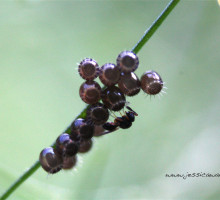
When someone hears the name stink bug, the likely reaction is a crunched up nose, a furrowed brow, and the utterance of the phrase “ewwww”. Having been subjected to the stench of these creatures on any number of occasions, I don’t blame them. With the majority of the 250 species of stink bugs in North America being plant-eating pests (and some of them serious ones at that), it’s easy to see why they have such a stinky reputation. The subfamily Asopinae, however, consists only of predatory species. These are the good guy stink bugs. All stink bugs stink. Even the beneficial species emit a distinct odor when handled or threatened. It is a defense mechanism—and a good one at that. Predaceous members of the stink bug family are known to consume common garden pests like caterpillars, Japanese beetles, Mexican bean beetles, Colorado potato beetle, lygus bug nymphs, beetle larvae, bollworms, herbivorous stink bugs, and others. Probably the most common and important predaceous stink bug is the spined soldier bug. The grayish brown adults have pointed shoulders with sharp points protruding from them. The rounded, wingless nymphs are orange with black markings. Spined soldier bugs, and other predaceous stink bugs, feed by stabbing prey with a knife-like mouthpart and consuming the innards. Spined soldier bugs are large, 0.35-0.55 in. (9-14 mm) long, and feed primarily at night. In addition, there are